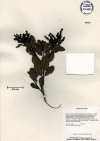Amanoacondorensis (Phyllanthaceae), a new shrubby species from the Cordillera del Condor in southern Ecuador
- PMID: 37303595
- PMCID: PMC10257137
- DOI: 10.3897/phytokeys.227.104703
Amanoacondorensis (Phyllanthaceae), a new shrubby species from the Cordillera del Condor in southern Ecuador
Abstract
A new species of Amanoa (Phyllanthaceae) is described from the sandstone Nangaritza Plateau in the Cordillera del Cóndor Region in southern Ecuador. Amanoacondorensis J.L.Clark & D.A.Neill is a small tree, 4 m tall that is only known from the type collection. The new species is distinct by a shrub habit, presence of coriaceous leaves with an acuminate apex, and congested inflorescences. The relatively high elevation of the type locality, presence of an androphore, and the habit as shrub or low tree are an unusual combination for Amanoa. The conservation status of A.condorensis is assessed as Critically Endangered (CR), based on IUCN Criteria.
ResumenSe describe una nueva especie de Amanoa (Phyllanthaceae) de la meseta de arenisca de Nangaritza en la región de la Cordillera del Cóndor en el sur de Ecuador. Amanoacondorensis J.L.Clark & D.A.Neill es un pequeño árbol de 4 metros de altura que sólo se conoce de la colección tipo. La nueva especie se distingue por la presencia de inflorescencias congestionadas, hojas coriáceas con ápice acuminado, y porte arbustivo. La elevación relativamente más alta de la localidad tipo, la presencia de un andróforo, y el hábito de arbusto o árbol pequeño son una combinación inusual para Amanoa. El estado de conservación de A.condorensis se evalúa como En Peligro Crítico (CR) según los Criterios de la UICN.
Keywords: Andean tepui; Andes; Ecuador; Nangaritza Plateau; Phyllanthaceae; androphore; taxonomy.
Conflict of interest statement
No conflict of interest was declared.
Figures


References
-
- Hayden WJ. (1990) Notes on Neotropical Amanoa (Euphorbiaceae). Brittonia 42(4): 260–270. 10.2307/2806814 - DOI
-
- Hayden WJ. (1999) Amanoa. In: Berry PE, Yatskievych K, Holst BK. (Eds) Flora of the Venezuela Guyana (Vol.5) Eriocaulaceae–Lentibulariaceae. Missouri Botanical Garden Press. St. Louis, Missouri, 95–99.
-
- Hoffmann P, Kathriarachchi H, Wurdack KJ. (2006) A Phylogenetic Classification of Phyllanthaceae (Malpighiales; Euphorbiaceaesensu lato. Kew Bulletin 61: 37–53.
-
- IUCN (2012) IUCN Red List Categories and Criteria: Version 3.1. (2nd edn.). Gland, Switzerland and Cambridge.
LinkOut - more resources
Full Text Sources
Miscellaneous
